 |
|||||||||||||
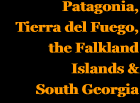 |
|||||||||||||
 |
|||||||||||||
 |
|||||||||||||
Main pages
Appendices
4 Pichi-Ropulli Osorno report •
9 Branchline station photos 2 •
11 Barros Jarpa Noel agreement ª
Chapter 5
The south end of the Chilean broad gauge


EFE diesel locomotives and multiple units
As on the Argentine state railways, the first diesel multiple units for express passenger use were ordered before the end of the 1930s, with diesel locomotives following in the 1950s. However, as usual, less important routes had to make do with older motive power for many years, and most of the southern branches thus retained steam traction until their eventual closure. The principle exception to this was the lightweight ADHI class of railcar by Ferrostaal O&K, introduced in 1970. There were, however, only five of these, and whilst one was seen on the Panguipulli branch it is not known if they ran regularly on other southern lines.
The table below lists the main types of broad gauge diesel power but, as with steam loco classes, only those that have played an important role on the most southerly lines have merited their own paragraphs below.
The Flecha del Sur
In 1940 the first pair of Flecha del Sur (Southern Arrow) articulated diesel sets were introduced, to provide an express service between Santiago and Puerto Montt in much the same way as the Trenes Bariloche sets on the FCE route to Bariloche in Argentina. There were eventually six of these three car units, AM101-6, but the delivery of several was delayed owing to the outbreak of the Second World War. They were intended to emulate the Fliegender Hamburger sets that had linked Hamburg with Berlin since 1933.
The three cars in each set were mounted on a total of four bogies, with the inner ones being powered by a diesel engine in each outer car. Construction was by Ferrostaal and MAN/AEG in Germany. The first car contained not only a cab and engine but also compartments for mail and luggage, a kitchen and a 15 seat bar. The second consisted of two saloons each taking 36 first class passengers, and the third was another driving power car but with this time a single 52 seat saloon.
A 7am departure from Santiago permitted an arrival in Puerto Montt soon after midnight – less than 17½ hours for 1080 km. – three times per week in winter and six in summer, with a Santiago to Concepción service also being run. Withdrawal came in 1960, owing to a supposed lack of spares, though it has been rumoured that some years later a vast stock was uncovered in a long-forgotten warehouse! (1)
A ‘Flecha del Sur’ set stands at Puerto Varas.
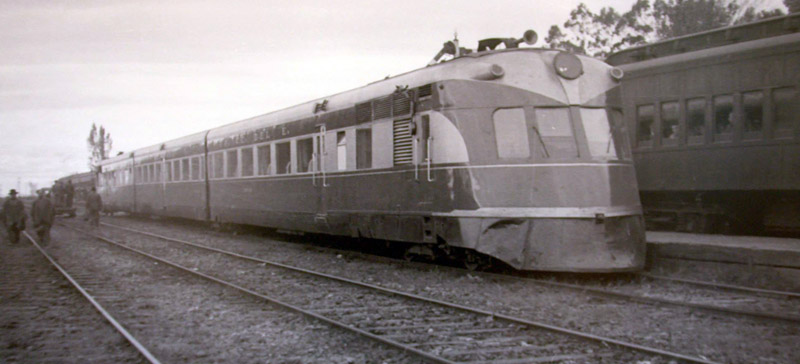
D160xx GE/ALCo Co-Co diesel electric ‘shovelnose’ locos
Twelve of these single cab machines arrived in 1954, with another five, slightly heavier, following on by 1957. They were of 1,600 hp, and theoretically weighed 105 or 110 tonnes. On arrival they were numbered from 7001 upward without a D prefix, but were soon renumbered into the D160xx series, under a system relating running numbers to horsepower. For the best part of forty years they were seen all over the broad gauge system, either singly or in multiple with another ‘shovel-nose’ or a D180xx ALCo hood unit. They seem to have been well liked, though drivers commented on the ‘kidney-bruising’ sideways oscillation on poor track. Five survived to be renumbered in the D16xx series when FePaSA knocked a zero out of most locomotive numbers after 1993. but only D1612 seems to be in use in 2013. It has seen service on the occasional tourist season train down to Puerto Varas, so the class can still be viewed in the south almost sixty years after their introduction.
One of the second batch of GE ‘shovelnose’ diesels, identifiable as such by the round GE badge beneath the cab windows, stands at the head of a long passenger train. The 70xx series numbers were soon succeeded by their better known D160xx designations.
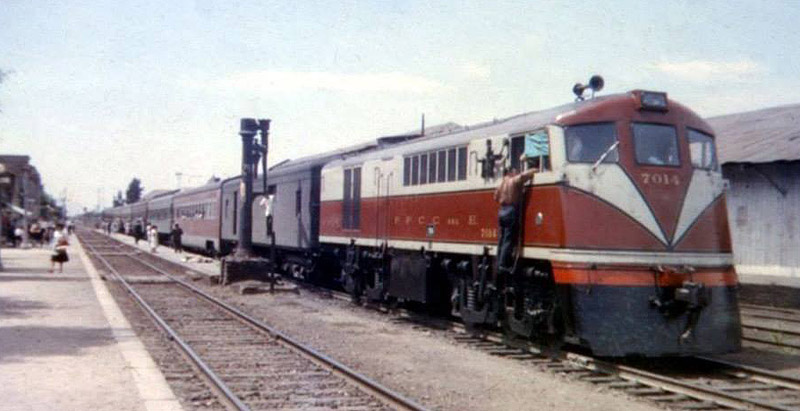
D180xx Alco Co-Co diesel electric locos
Ten of these ALCo DL-541 RSD 20 locomotives arrived in Chile in 1961. The 12 cylinder engine produced 1800 hp. Formerly they were used to pull both passenger and goods trains, singly or in pairs, but since privatisation are used by FePaSA on freight service. When they belonged to the EFE they were numbered from D18001 upwards, but the survivors lost a zero and are now therefore numbered D18xx.
One of the everlasting ALCos in a late livery just before privatisation.
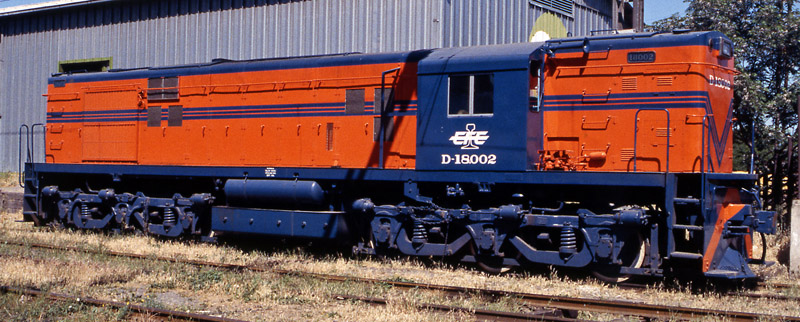
D7100 Brissoneau et Lotz Bo-Bo diesels
Forty-nine of these compact 825 hp Bo-Bo diesels were built for Chile by the French Brissonneau et Lotz company, later to become part of Alsthom, in 1963. They were originally supplied to the SNCF as their class BB63400, but similar machines were also provided for a number of other countries, such as Portugal and Jugoslavia. They incorporate a SACM diesel engine of type MGO-V12-175.
Whilst they have been extremely versatile locomotives, in the past they were rarely found south of Temuco. However, the few survivors can now be spotted anywhere on the Red Sur system, working for EFE, FePaSA and for the infrastructure contractor CTF, and thus finding employment on maintenance trains down to Puerto Montt.
Another loco in that late orange and blue livery, this time a Brisssoneau et Lotz Bo-Bo.
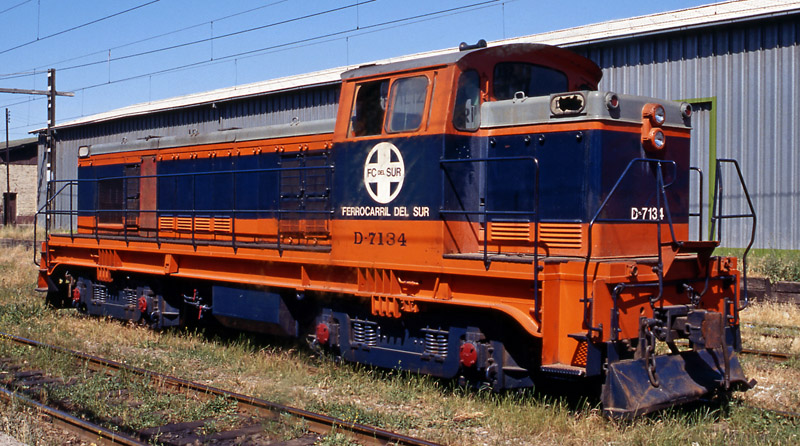
Twin Coach diesel bus-carriles
Whilst trials with bus-carriles on the broad gauge had taken place as early as the 1920s, the first substantial order came in the late 1940s, for what were literally modified buses, built by the firm of Twin Coach in Ohio, USA. This company’s vehicles were notable for their integral construction. The bus division, which also built trolley-buses, was sold to Flxible in 1955. The batch of twelve built for the EFE, following on from six constructed for the Missouri Pacific Railroad in 1947, seem to have been the only Twin Coach rail vehicles (2). They were based on the type 41-S petrol/gasoline-engined buses built between 1944 and 1951, so-called because they seated 41 passengers, but the Chilean vehicles were equipped with a diesel engine and manual transmission. The EFE buscarriles were classified 41-SDMRC by their builder, and numbered 1301-12 by the railways (3). They saw most use around Concepción, though they may have ventured further south on test.
The Ferrostaal O&K cars
Around 1970 a small batch of light weight railcars and trailers was produced by O&K in Germany through the Ferrostaal company. These operated on the Panguipulli and other branches. They required only a two man crew, and were simple and economical to operate, but did tend to suffer from overheating of the engines.
Motive power in the FePaSA era
The decline in traffic levels and the consequent deteriorating financial situation of the state railways through the 1970s and ‘80s, coupled with electrification nearer to the capital, meant that no important broad gauge diesel purchases had been made after the arrivals of the D180xx ALCos in the 1960s. However, after privatisation of freight services in 1993, FePaSA, and later TransAP, soon decided that more modern motive power was needed. The lively second-hand market within the USA meant that suitable locomotives were available at a reasonable price, albeit with the need to provide replacement 5’ 6” gauge bogies.
Thus the majority of the current broad gauge diesel locos running on the Red Sur have come from elsewhere. There are a few old stagers from EFE days still in use, particularly the everlasting ALCos, but any heavy haulage tends to be handled by EMD Co-Co hood units that previously ran on a variety of US railroads. Many of these were previously four-axled ‘Geeps’, but the need to replace the bogies and simultaneously to reduce the axle loading has meant that they have become six-axled locos classified within the various sub-divisions of SD 39s and 40s.
Less successful have been a batch of EMD G8 Bo-Bos from the Korean Railways and a trial pair of GE B23-7s rebuilt onto six axles by the Chilean engineering company Casagrande Motori of Santiago.
At the other end of the power range, the need for small locomotives that can work with track gangs, has resulted in a number of regaugings from the northern Chilean metre gauge system. Thus GE centre-cab 44-tonners dating from the late 1940s can be seen occasionally right down to Puerto Montt.
Even stranger, the infrastructure company OHL, a sub-contractor to EFE for track maintenance, has used four-wheeled shunters that were originally built for the metre gauge Compañía Gaditana de Minas de la Caridad, of Aznalcollár in Spain (4). The one illustrated over the page is a Deutz model KG275BS, No. 58225, built in 1969. On the closure of that railway, it and three sister locos were regauged to 5’ 6” and shipped to Chile in 2001. They then began work for the Spanish-owned OHL Concesiones Chile SA on mainline track relaying and maintenance contracts. This particular machine, officially D-01 ‘Virgen de la Esperanza’ since its days in Spain but known less formally as La Zapatilla (‘the slipper’, from its distinctive shape), spent its last years on the stretch of mainline between San Rosendo and La Unión, but has since then lain out of use in Osorno yard (5). Surprisingly, it carries European-style side buffers and drawhook, which cannot have made life easy when manœuvring Chilean wagons! More recently, it came to prominence in the Chilean press when an attempt to spirit it away to Valdivia for preservation came to light!
Sources
1 Dietrich Angerstein, 2000, Rapidez, puntualidad, seguridad, an article on the Flecha del Sur trains in the ACCPF’s En Tren magazine issue No. 8, p17.
2 List of Twin Coach series 41 deliveries at http://www.omot.org/roster/twincoach/41s.htm
3 http://www.coachbuilt.com/bui/t/twin_coach/twin_coach.htm
4
5
11-3-2018